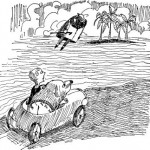I completed chapter one of Game Writing: Narrative Skills for Videogames edited by Chris Bateman today. Below are my notes.
Terms:
- Story
- Character
- Setting
- Backstory
- Cut scenes
- Scripted events
- In-Game Artifacts
The purpose of game narrative?
- Immersion
- Reward
- Identification
Words/Terms I didn’t know?
- “barks” – short interjections, most often said by NPCs, usually a large number of these are required for the entire game.
- iterative – in this case, a development strategy which allows for time to rework, revise, and improve elements of a system. In this case, referring to cut scenes.
Game development<->literature concept I should have thought of before:
-
The integration of a classic style story arc into gameplay. Pg13: “In gaming, the challenges, fights, and puzzles get more and more intense until the climax, which is often rendered as a boss fight. After this the player is rewarded with denouement and, possibly, power ups.”
- Bonus Example: Bioshock: Battles with little sisters then receiving EVE. Even better: The final boss fight is followed up with a classic literary-style denouement. Bioshock‘s extremely linier format provides it with a very literary-story concept and flow.
Game development<->literature concept I already know:
- The importance of maintaining the fictional dream. Pg17: “It’s worse than no good if the writing calls attention to itself, instead of the player, or it jerks the player out of the game’s fantasy by disrupting the narrative flow.”
- Forced failure works great in books, horribly in games. I knew that one, I’ve experienced it. *cough*darkforcesseries*cough* (pg18)
Thought-provoker: Pg17: (on long cut scenes, with reference to tense but long conversations) “…they are not playing, and that can be deadly to a game.”
- This sentence, partnered with the previous reference made me think of Fahrenheit. This was in many ways a classic mystery story and had the elements of these tense but long conversations. It was able to drive them along and keep the player paying attention by mapping certain conversational ploys or in-conversation actions to joystick movements. It occurs to me now just how excellent this concept would be on a motion sensitive controlled console like the Wii. Imagine having to jab in order to say something pointed, or physically pull back when you have to pull back in a conversation. If done properly, so that the game would require us to make the usual conversational motions and tics, it would add a lot of depth to a game and a console which is looking for real innovative use of a motion sensitive controller. The conversations would be driven by a player moving as if he is actually having a conversation.
Important to the Industry:
- The bit on handling a franchise on page 16.
Further Notes:
This chapter was more of an introduction than anything else. It still was quite interesting. Hopefully the rest of the text is as good as the stepping-off point.




























